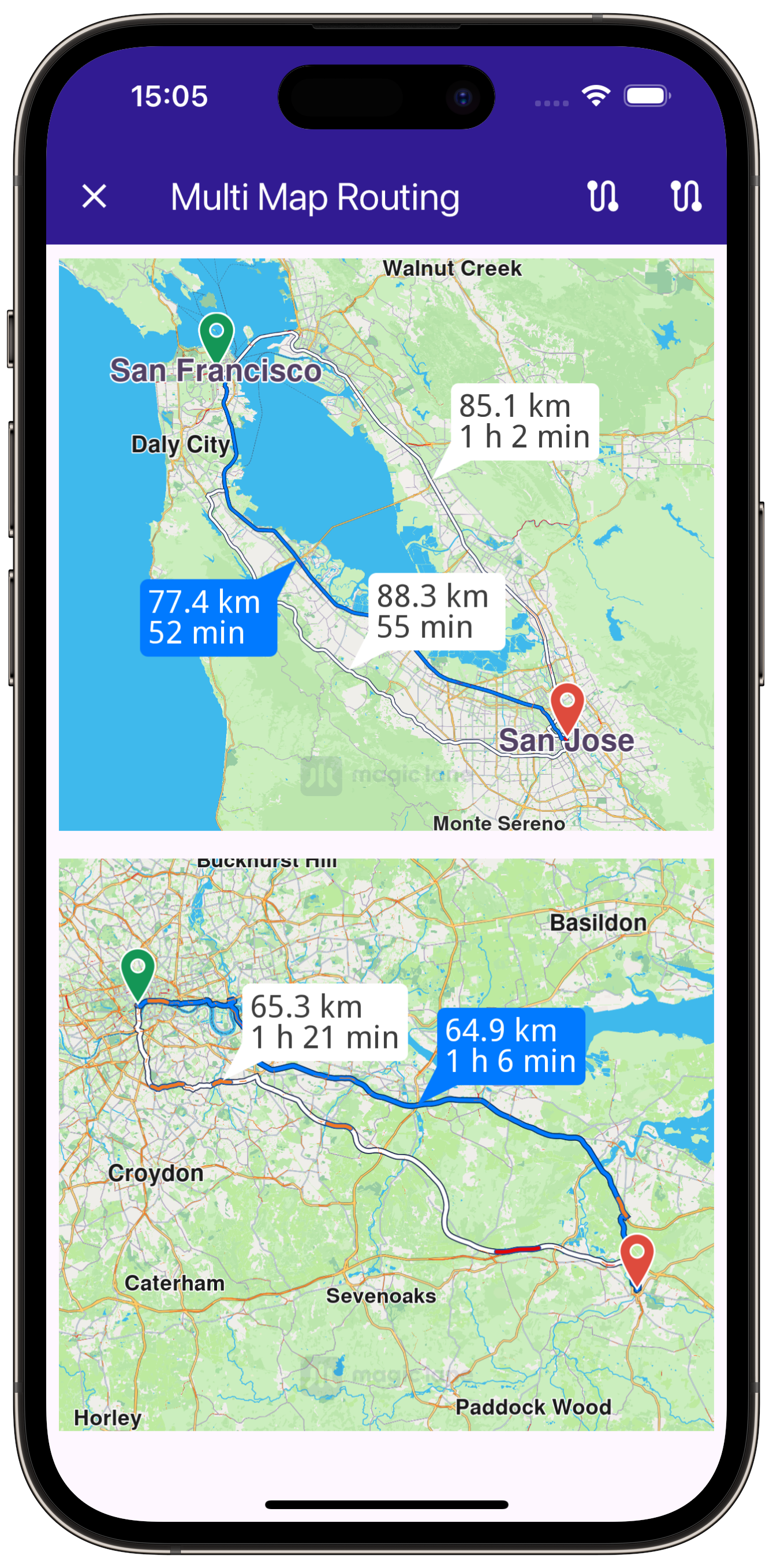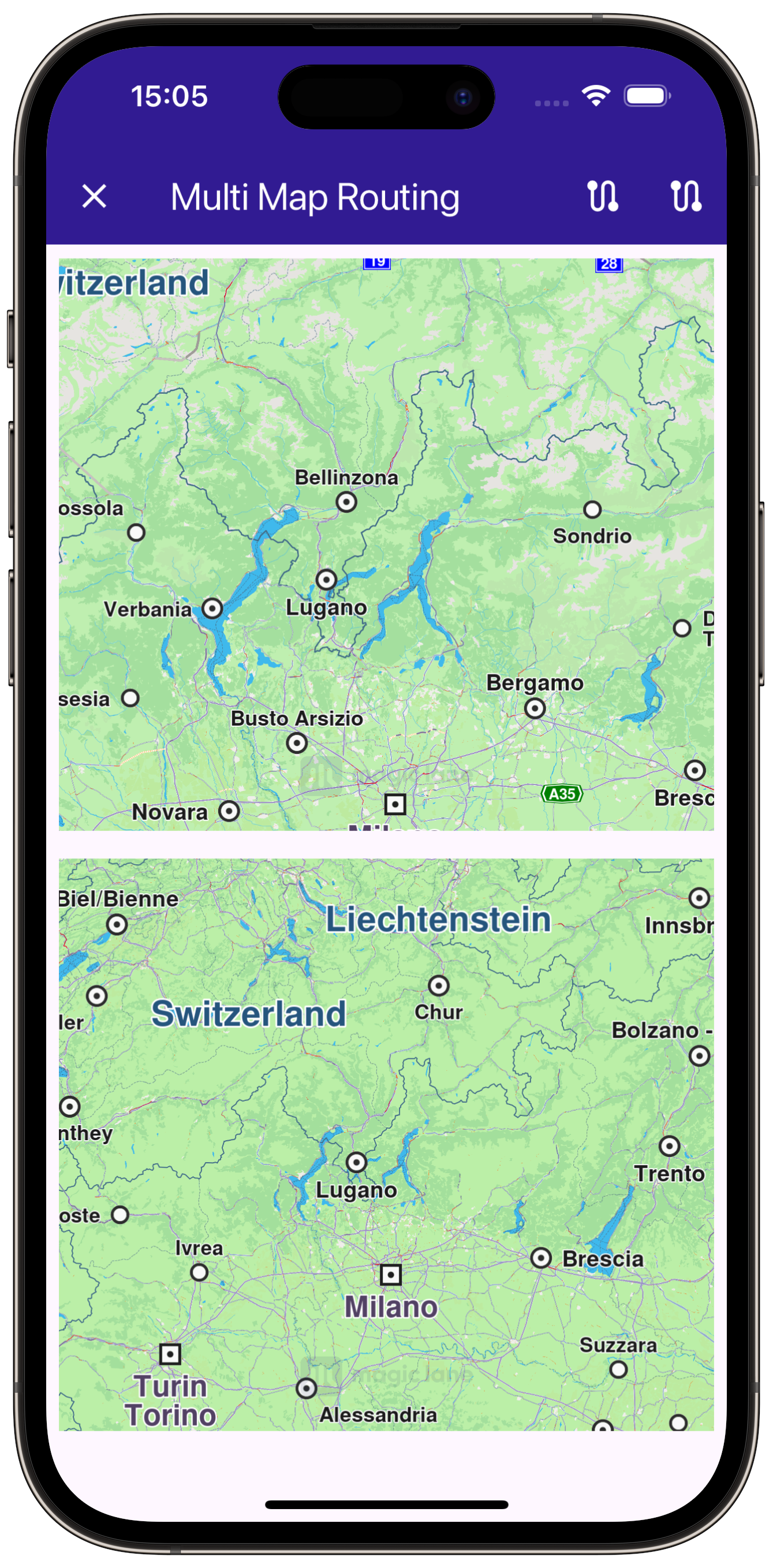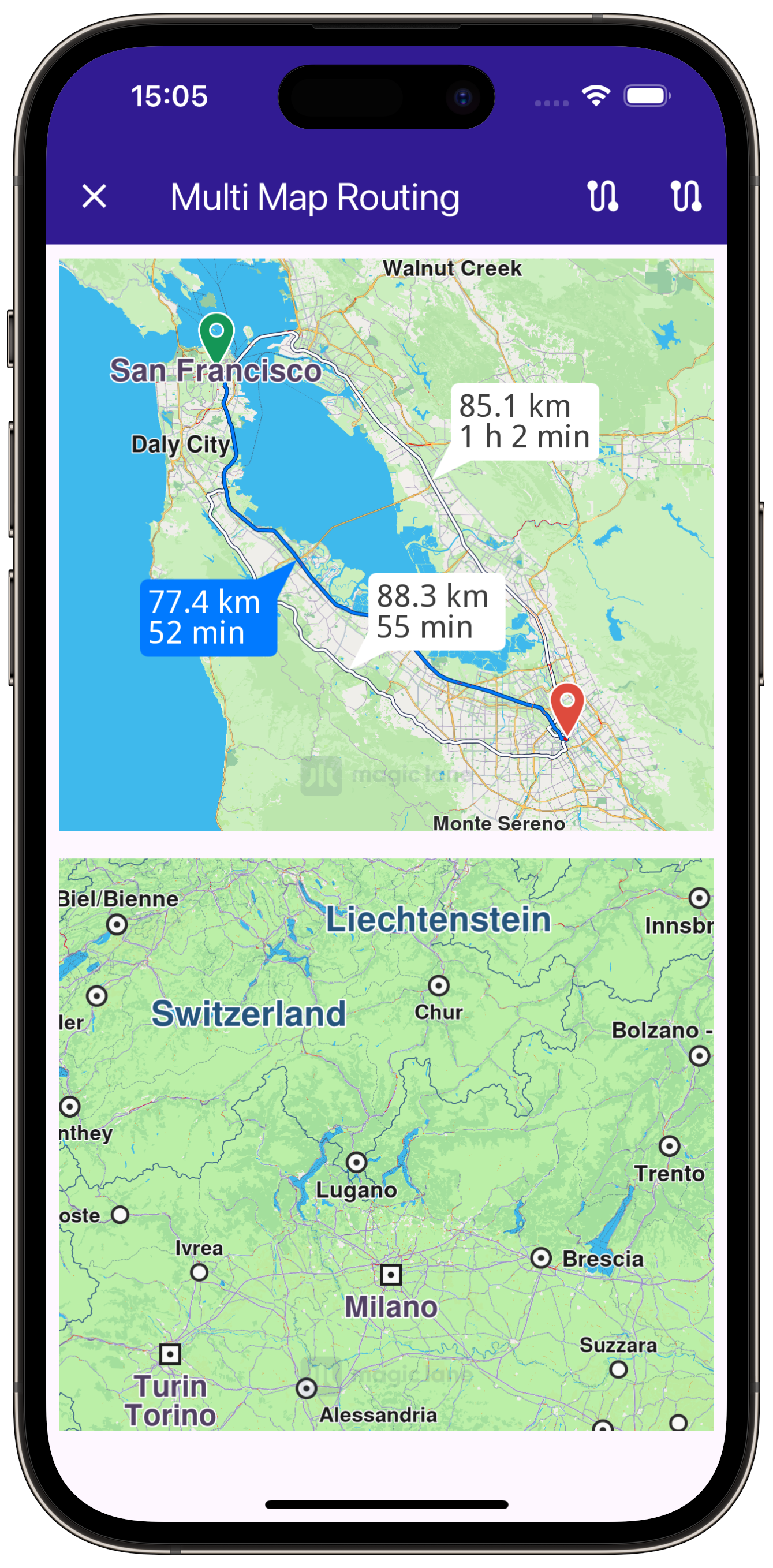Multi Map Routing¶
In this guide, you will learn how to implement multi-map routing functionality using the gem_kit package. This example demonstrates how to manage routes on two maps simultaneously.
|
|||
Setup¶
Prerequisites¶
Build and Run¶
Start a terminal/command prompt and navigate to the multi_map_routing directory within the Flutter examples directory. This is the name of the example project.
Note - the gem_kit directory containing the Maps SDK for Flutter
should be in the plugins directory of the example, e.g.
example_pathname/plugins/gem_kit - see the environment setup guide above.
Run: flutter pub get
Configure the native parts:
First, verify that the ANDROID_SDK_ROOT environment variable
is set to the root path of your android SDK.
In android/build.gradle add the maven block as shown,
within the allprojects block, for both debug and release builds:
allprojects {
repositories {
google()
mavenCentral()
maven {
url "${rootDir}/../plugins/gem_kit/android/build"
}
}
}
in android/app/build.gradle
within the android block, in the defaultConfig block,
the android SDK version minSdk must be set as shown below.
Additionally, for release builds, in android/app/build.gradle,
within the android block, add the buildTypes block as shown:
Replace example_pathname with the actual project pathname
android {
defaultConfig {
applicationId "com.magiclane.gem_kit.examples.example_pathname"
minSdk 21
targetSdk flutter.targetSdk
versionCode flutterVersionCode.toInteger()
versionName flutterVersionName
}
buildTypes {
release {
minifyEnabled false
shrinkResources false
// TODO: Add your own signing config for the release build.
// Signing with the debug keys for now, so `flutter run --release` works.
signingConfig signingConfigs.debug
}
}
}
Then run the project:
flutter run --debugorflutter run --release
App entry and initialization¶
const projectApiToken = String.fromEnvironment('GEM_TOKEN');
void main() {
runApp(const MyApp());
}
This code initializes the projectApiToken with the required authorization token and launches the app.
How it Works¶
This example demonstrates the following features:
Interact with and manage routing functionalities on two separate maps within the same application.
Create and calculate routes with specified waypoints and preferences for each map independently.
|
|||
|
|||
Build the Main Application¶
Define the main application widget, MyApp.
class MyApp extends StatelessWidget {
const MyApp({super.key});
@override
Widget build(BuildContext context) {
return const MaterialApp(
title: 'Multi Map Routing',
debugShowCheckedModeBanner: false,
home: MyHomePage());
}
}
Handle Maps and Routes in the Stateful Widget¶
Create the stateful widget, MyHomePage, which will handle two maps and their respective routes.
class MyHomePage extends StatefulWidget {
const MyHomePage({super.key});
@override
State<MyHomePage> createState() => _MyHomePageState();
}
Define State Variables and Methods¶
Within _MyHomePageState, define the necessary state variables and methods to interact with the maps and manage routes.
class _MyHomePageState extends State<MyHomePage> {
late Controller _mapController1;
late Controller _mapController2;
TaskHandler? _routingHandler1;
TaskHandler? _routingHandler2;
@override
void dispose() {
GemKit.release();
super.dispose();
}
@override
Widget build(BuildContext context) {
return Scaffold(
appBar: AppBar(
backgroundColor: Colors.deepPurple[900],
title: const Text('Multi Map Routing',
style: TextStyle(color: Colors.white)),
leading: IconButton(
onPressed: _removeRoutes,
icon: const Icon(
Icons.close,
color: Colors.white,
)),
actions: [
IconButton(
onPressed: () => _onBuildRouteButtonPressed(true),
icon: const Icon(
Icons.route,
color: Colors.white,
)),
IconButton(
onPressed: () => _onBuildRouteButtonPressed(false),
icon: const Icon(
Icons.route,
color: Colors.white,
))
],
),
body: Column(
children: [
SizedBox(
height: MediaQuery.of(context).size.height / 2 - 50,
child: Padding(
padding: const EdgeInsets.all(8.0),
child: (
onMapCreated: _onMap1Created,
appAuthorization: projectApiToken,
),
),
),
SizedBox(
height: MediaQuery.of(context).size.height / 2 - 50,
child: Padding(
padding: const EdgeInsets.all(8.0),
child: (
onMapCreated: _onMap2Created,
appAuthorization: projectApiToken,
),
),
),
],
),
);
}
void _showSnackBar(BuildContext context,
{required String message, Duration duration = const Duration(hours: 1)}) {
final snackBar = SnackBar(
content: Text(message),
duration: duration,
);
ScaffoldMessenger.of(context).showSnackBar(snackBar);
}
void _onMap1Created(GemMapController controller) {
_mapController1 = controller;
}
void _onMap2Created(GemMapController controller) {
_mapController2 = controller;
}
void _onBuildRouteButtonPressed(bool isFirstMap) {
final waypoints = <Landmark>[];
if (isFirstMap) {
final departure =
Landmark.withLatLng(latitude: 37.77903, longitude: -122.41991);
final destination =
Landmark.withLatLng(latitude: 37.33619, longitude: -121.89058);
waypoints.add(departure);
waypoints.add(destination);
} else {
final departure =
Landmark.withLatLng(latitude: 51.50732, longitude: -0.12765);
final destination =
Landmark.withLatLng(latitude: 51.27483, longitude: 0.52316);
waypoints.add(departure);
waypoints.add(destination);
}
final routePreferences = RoutePreferences();
_showSnackBar(context,
message: isFirstMap
? 'The first route is calculating.'
: 'The second route is calculating.');
if (isFirstMap) {
_routingHandler1 = RoutingService.calculateRoute(
waypoints,
routePreferences,
(err, routes) => _onRouteBuiltFinished(err, routes, true));
} else {
_routingHandler2 = RoutingService.calculateRoute(
waypoints,
routePreferences,
(err, routes) => _onRouteBuiltFinished(err, routes, false));
}
}
void _onRouteBuiltFinished(
GemError err, List<Route>? routes, bool isFirstMap) {
if (isFirstMap) {
_routingHandler1 = null;
} else {
_routingHandler2 = null;
}
ScaffoldMessenger.of(context).clearSnackBars();
if (_routingHandler1 != null) {
_showSnackBar(context, message: 'The first route is calculating.');
}
if (_routingHandler2 != null) {
_showSnackBar(context, message: 'The second route is calculating.');
}
if (err == GemError.success) {
final routesMap = (isFirstMap
? _mapController1.preferences
: _mapController2.preferences)
.routes;
for (final route in routes!) {
routesMap.add(route, route == routes.first,
label: route.getMapLabel());
}
if (isFirstMap) {
_mapController1.centerOnRoutes(routes);
} else {
_mapController2.centerOnRoutes(routes);
}
}
}
void _removeRoutes() {
if (_routingHandler1 != null) {
RoutingService.cancelRoute(_routingHandler1!);
_routingHandler1 = null;
}
if (_routingHandler2 != null) {
RoutingService.cancelRoute(_routingHandler2!);
_routingHandler2 = null;
}
_mapController1.preferences.routes.clear();
_mapController2.preferences.routes.clear();
}
}




